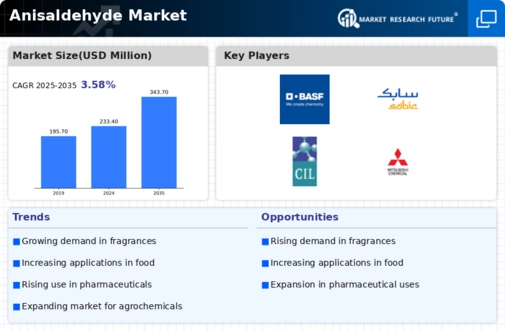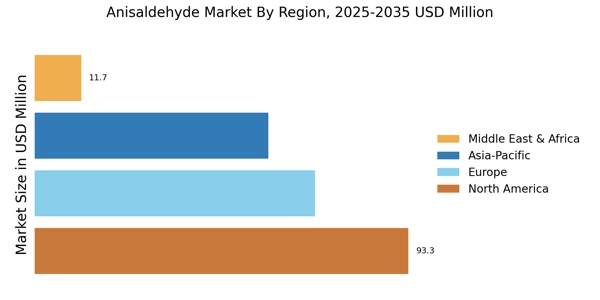Rising Demand in Fragrance Industry
The Anisaldehyde Market is experiencing a notable surge in demand, particularly within the fragrance sector. Anisaldehyde Market is a key ingredient in the formulation of perfumes and scented products, valued for its sweet, floral aroma. As consumer preferences shift towards more natural and unique fragrances, manufacturers are increasingly incorporating anisaldehyde into their formulations. The fragrance market is projected to grow at a compound annual growth rate of approximately 5% over the next few years, which is likely to bolster the anisaldehyde market. This trend indicates a robust potential for growth, as brands seek to differentiate their products through innovative scent profiles, thereby driving the demand for anisaldehyde in the fragrance industry.
Growth in Pharmaceutical Applications
The Anisaldehyde Market is also benefiting from its applications in the pharmaceutical sector. Anisaldehyde Market is recognized for its role as an intermediate in the synthesis of various pharmaceutical compounds. The increasing focus on research and development in the pharmaceutical industry is likely to drive the demand for anisaldehyde as a key ingredient in drug formulation. With the pharmaceutical market projected to expand at a CAGR of approximately 6% in the next few years, the anisaldehyde market stands to gain from this growth. The versatility of anisaldehyde in synthesizing active pharmaceutical ingredients suggests a promising future for its utilization in the pharmaceutical industry.
Technological Advancements in Production
The Anisaldehyde Market is poised for growth due to ongoing technological advancements in production processes. Innovations in manufacturing techniques are enhancing the efficiency and cost-effectiveness of anisaldehyde production. These advancements not only improve yield but also reduce environmental impact, aligning with the increasing emphasis on sustainability in chemical manufacturing. As production becomes more streamlined, the availability of anisaldehyde is likely to increase, meeting the rising demand across various sectors. This trend indicates a positive outlook for the anisaldehyde market, as manufacturers leverage technology to optimize production and cater to diverse applications.
Expansion in Food and Beverage Applications
The Anisaldehyde Market is witnessing an expansion in its applications within the food and beverage sector. Anisaldehyde Market is utilized as a flavoring agent, imparting a distinct taste to various food products, including baked goods and confectionery. The increasing consumer inclination towards unique and exotic flavors is propelling food manufacturers to explore anisaldehyde as a viable option. Market data suggests that the food flavoring industry is expected to grow significantly, with a projected CAGR of around 4% in the coming years. This growth is likely to enhance the demand for anisaldehyde, as food producers aim to innovate and cater to evolving consumer tastes, thus creating new opportunities within the anisaldehyde market.
Increasing Awareness of Natural Ingredients
The Anisaldehyde Market is influenced by the growing consumer awareness regarding natural ingredients in products. As consumers become more health-conscious, there is a marked shift towards products that contain natural and organic components. Anisaldehyde Market, derived from natural sources, is gaining traction as a preferred ingredient in various applications, including cosmetics and personal care products. Market trends indicate that the demand for natural ingredients is expected to rise, with a projected growth rate of around 5% in the personal care sector. This shift towards natural formulations is likely to enhance the appeal of anisaldehyde, positioning it favorably within the anisaldehyde market.


















Leave a Comment